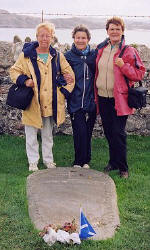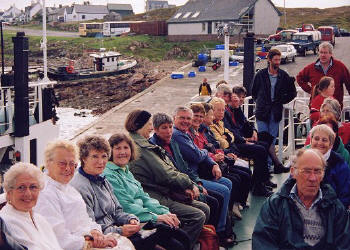|
The pilgrims end their weekend with a special service in St Cuthbert's |
|
|
At the grave of former Labour leader John Smith |
Some of the party on the boat from Mull to Iona |
|
Maybole parishioners' weekend pilgrimage to Holy Iona St Columba is a saint who, even after fourteen hundred years, has a fascination for many people, especially Scots. Born in Ireland, in Donegal in the year 521, was of royal blood, and might have become High King of Ireland had he not chosen to be a priest. Last weekend parishioners from Our Lady and St Cuthbertís Church, Maybole, along with some members of other local churches, set off to follow in his footsteps on the island of Iona, one of Scotlandís most sacred sites. Iona is a small island off the west coast of Scotland, where in 563 AD Columba founded a Celtic monastery that in the middle ages became the site of a Benedictine abbey and over the centuries has attracted many thousands of people on their own pilgrim journeys. On Friday 20th September the Maybole pilgrims met at St Cuthbertís just after 8am for Mass and prayer for what Fr Jim Hayes, who was leading the group, described as "a safe and grace filled pilgrimage". They set off by bus at 9am and stopped for a short break at Luss, where "Take the High Road" is filmed. After lunch in Oban, they took a 45 minute ferry journey to Craignure, on the island of Mull. As it was a day of brilliant sunshine many of the group sat at the back of the boat and enjoyed the beautiful scenery. The following day they left their hotel at 9am for the 75 minute journey across Mull by single track road to the ferry point and the 5 minute crossings to Iona. Of all the sacred places in Scotland, Iona is regarded as an enduring symbol of Christianity since St Columba arrived with twelve others to found the monastery which was to become one of the most important in Europe. The visitors leisurely walked around the famous gravestones of monks, kings and John Smith, the leader of the Labour Party who died in 1994. Many also visited St Oranís Chapel, the oldest of Ionaís surviving ecclesiastical buildings. It was used as a chapel and the burial place of the Macdonald family, the Lords of the Isles. A walk from the chapel along the cobbled Street of the Dead took them to St Martinís Cross, the only one left intact of four high crosses which once stood in the area. This was followed by a guided tour of the Abbey. Unfortunately, a planned 2pm service for peace and justice in the Abbey led by the Iona Community had to be cancelled as there was a wedding taking place. Instead, the group held their own service in the Michael Chapel. This was followed by Mass in the Catholic House of Prayer known as "Cnoc a' Chalmain". The Iona Community was founded in 1938 by the Rev George MacLeod, a parish minister in Glasgow, and is an ecumenical Christian community committed to seeking new ways of living the Gospel in today's world. Initially this was expressed through the rebuilding of the monastic quarters of the abbey and then in mission and ministry throughout Scotland and beyond. The Community today is still committed to working for social and political change, the renewal of the church with an ecumenical emphasis, and more inclusive approaches to worship. The following morning it was time to start packing for the 11am ferry back to Oban and Mass in St Columbaís Cathedral. Then it was back on the bus for the trip home, this time via Inverary, and a final service of Thanksgiving in St Cuthbertís Church to end the pilgrimage. Everyone agreed it had been a great weekend not only for the spiritual pilgrimage but also for the companionship and friendliness experienced. (Ayrshire Post October 4th 2002) |
|

